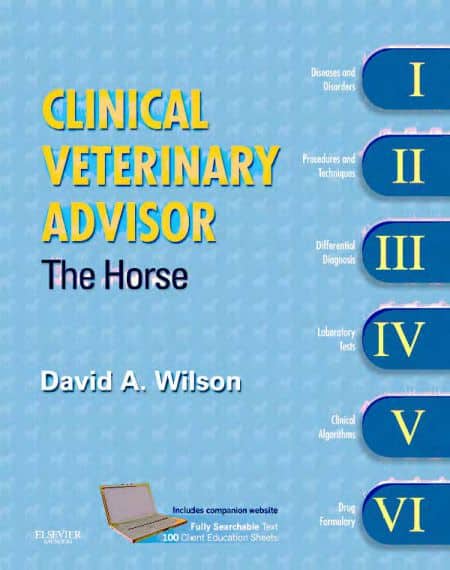Clinical Veterinary Advisor: The Horse, No other equine quick reference comes close to providing this much accurate, timely, and clinically useful diagnostic and therapeutic information.
Clinical Veterinary Advisor: The Horse

Keeping pace with the growing body of knowledge in any one part of veterinary medicine, let alone staying current in all of them, is an enormous challenge. As veterinarians, we see the extremes of the spectrum for published veterinary resources. On one end of the spectrum are definitive, peer-reviewed manuscripts in specialty publications that are the gold standard for accuracy. For a busy practitioner, however, these sources may contain too much detail to be immediately useful in a daily clinical setting. On the other end of the spectrum, simplified information may be more accessible, but the appeal can be hollow if the information is not peer reviewed or, in some cases, not even scientifically defensible.
The purpose of the Clinical Veterinary Advisor is to provide an entry point between these two extremes by using a template-based format, photographs, and a multi section approach. It aims to present a concise review of the most useful information while covering six of the major facets of equine practice: diseases and disorders, procedures and techniques, differential diagnoses, algorithm-based decision making, laboratory tests, and medications. As a bridge between the comprehensive coverage of a specialty text and a quick reference guide, the Clinical Veterinary Advisor has been created to present the information that practitioners seek when we turn to a reference for help.
Section I, Diseases and Disorders, describes the most important elements of commonly encountered illnesses and presenting complaints of horses. The material is presented in a way that follows the natural progression of a typical case: back-ground information is presented first, including the definition of the topic, synonyms, and epidemiologic facts. Next, the chief complaint at the time the appointment was made and typical history are presented.
The remainder of the material in a Dis-eases and Disorders topic is likewise presented according to the process followed during the veterinary visit or in the veterinary hospital. For example, diagnostic testing is presented in two parts. Initial database tests come first; these are diagnostic tests that are routinely performed in an initial workup. Immediately afterward comes advanced or confirmatory testing, which encompasses the more-specific tests that may be indicated based on initial results or tests that may require more expensive equipment or advanced techniques. These are sometimes done in a general practice and in other cases require referral to a university hospital or specialty center. Similarly, treatment is described as acute treatment first, followed by chronic treatment. Drug dosages and routes of administration are included so the reader does not have to leaf through the Drug Formulary for every medication. The end of each topic includes a section for clinical tips, which are the most useful nuggets of information according to the experience of the author and editor—points we want to bring to the reader’s attention, easily made mistakes to avoid, or other useful insights.
Direct Link For Paid Membership: –
This Book is Available For Premium Members Only (Register Here)
Unlock 3000+ Veterinary eBooks or Go To Free Download
Direct Link For Free Membership: –
| Book Name: | Clinical Veterinary Advisor: The Horse | |
| File Size: | 25 MB | |
| File Format: | ||
| Download Link: | Click Here | |
| Password: | PDFLibrary.Net (if Required) | |
